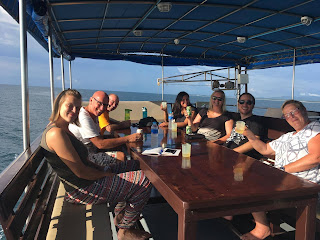KHAO LAK DIVING
The Local Dive Sites of Khao Lak
The town of Khao Lak has mainly won its fame as a dive destination through its proximity to the Similan Islands. For those with the time to spare a Similan Islands Diving Liveaboard Cruise is a wonderful experience and offers amazing diving for all levels of diver certification.
Because the wrecks are closer to shore, logistics are different from the Similans Islands day trips also offered through Oktavia Dive Center. Generally, you will be picked up from your hotel around 8-9AM, and return to your hotel around 3-4PM in the afternoon. You have a light lunch on the boat between the two dives, and the diving is done from either speedboat or a traditional Thai long-tail boat.


As you descend along the mooring line, you will often not see the wreck, because it is hidden below large schools of fish. First you will meet large numbers of yellow snapper, trevally, barracuda, and batfish. As you get closer to the wreck you find hundreds of lionfish, moray eels in various types and sizes, scorpionfish and even stonefish. We regularly spot nudibranchs and frogfish as well as stingrays. Some divers have even been fortunate enough to see whaleshark at this dive site! For photographers, this is macro heaven and even though visibility isn’t as impressive as the Similan Islands, Boonsung Wreck is the favourite dive site of quite a few dive pro’s in the region.
Because of the depth we highly recommend diving with Enriched Air 32% to extend the bottom time.

A vast amount of marine life can be found already now, ranging from nudibranchs and frogfish over octopus and cuttlefish to big schools of batfish and rainbow runners. This is a perfect site for technical diving as well as the last dives of the Padi Deep Diver Specialty.


Boonsung Wreck
The most famous of the three is “Boonsung Wreck”. It’s a 60 meter long marine tin ore processing vessel, which sunk in 1984 and now sits on the sandy bottom at 18-20 meters. The wreck was broken into 5 large pieces during the 2004 tsunami and penetration is not possible. The Boonsung Wreck has won its reputation as the best local dive site in Khao Lak, not because of the wreck itself, but because of the unbelievable marine life in, on and around the wreck.As you descend along the mooring line, you will often not see the wreck, because it is hidden below large schools of fish. First you will meet large numbers of yellow snapper, trevally, barracuda, and batfish. As you get closer to the wreck you find hundreds of lionfish, moray eels in various types and sizes, scorpionfish and even stonefish. We regularly spot nudibranchs and frogfish as well as stingrays. Some divers have even been fortunate enough to see whaleshark at this dive site! For photographers, this is macro heaven and even though visibility isn’t as impressive as the Similan Islands, Boonsung Wreck is the favourite dive site of quite a few dive pro’s in the region.
We definitely recommend diving with Enriched Air 32% on this dive site to extend bottom time.
- Depth: 12-19 meters (40-63 ft)
- Visibility: 5-20 meters (16-65 ft)
- Currents: generally moderate
- Level: intermediate to advanced
Premchai Wreck
Premchai Wreck is also an old tin mining boat, but was sank for the purpose of recreational diver in 2001. Because of her relatively young age, the growth isn’t as extensive here as it is on the Boonsung Wreck. However, the marine life is mind-blowing; both in terms of diversity and quantity. In addition to various types of moray eels, scorpion fish, and lion fish, we also find both nudibranchs and ghost pipefish regularly at this site. The wreck lies on her side at approx. 20 meters (66 ft) and is still in great condition. It appears that the wreck attracts more fish with each year and she has become quite a sanctuary for various juvenile fish species.Because of the depth we highly recommend diving with Enriched Air 32% to extend the bottom time.
- Depth: 16-21 meters (52-69 ft)
- Visibility: 5-15 meters (16-50 ft)
- Currents: generally moderate
- Level: intermediate to advanced
Sea Chart Wreck
A bulk carrier with 1200 logs of teak wood sank in rough weather just offshore from Khao Lak in August 2009; but fortunately no lives were lost. The wreck now lies on her starboard side in approx. 40 meter’s depth (132 ft). With a length of 84 meters (280ft) and width of 12 meters (40 ft) she is a spectacular and impressive wreck, which is further enhanced through her intact appearance.
A vast amount of marine life can be found already now, ranging from nudibranchs and frogfish over octopus and cuttlefish to big schools of batfish and rainbow runners. This is a perfect site for technical diving as well as the last dives of the Padi Deep Diver Specialty.
- Depth: 28-40 meters (92-132 ft)
- Visibility: 5-20 meters (16-65 ft)
- Currents: generally moderate
- Level: Advanced Open Water divers, preferably with deep and enriched air specialties. Minimum advanced open water certified with logbook showing dive(s) to similar depths within the past 6 months.



Comments
Post a Comment